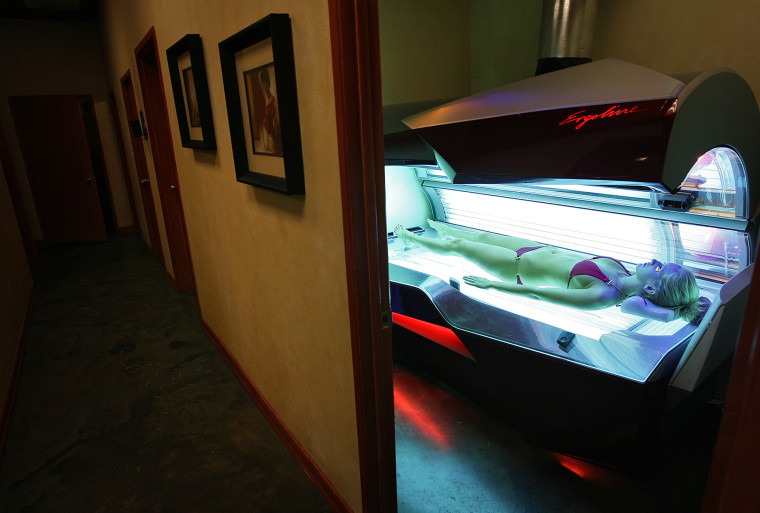The Food and Drug Administration proposed unprecedented new rules Friday that would bar anyone under 18 from using a sunlamp or indoor tanning device.
The proposed new rules also would require anyone over 18 who uses a tanning salon or other product to sign a certification saying they understand the risks — which include skin cancer and severe burns.
And the FDA, which regulates the tanning beds and sunlamps as medical devices, said it would force manufacturers to make already required warning labels more prominent, add a "panic" button to turn the lamp off, and make other safety modifications.
RELATED: Pineapple pesticide linked to Parkinson's disease
Too many people still believe that indoor tanning is somehow safer than being out in the sun. It isn't, said Dr. Vasum Peiris, chief medical officer in the FDA's division that regulates medical devices for children.
"Indoor tanning is designed to deliver large amounts of UV (ultraviolet) radiation in a short time," Peiris told reporters.
Some of the lamps can deliver 10 to 15 times the intensity of the midday sun, he said.
"The FDA's long-awaited tanning device proposals are an important step that will help to reduce skin cancer diagnoses and deaths," the American Cancer Society's Cancer Action Network, which advocates in Washington on health issues, said in a statement.
"We commend the FDA for educating the public about the dangers of exposure to harmful ultraviolet radiation and restricting use for our nation's youth. Indoor tanning devices are not safe."
The FDA has been gradually ratcheting up the warnings on tanning beds and lamps. They must already carry a "black-box" warning saying they should not be used by people under 18.
Peiris said the FDA has not made final decisions on how it would enforce the rules. The agency can seize products that don't meet standards, and can also work with the Justice Department, state and local government and other agencies to bring civil and criminal charges against repeat offenders.
RELATED: This virus you never heard of may be causing birth defects in Brazil
"The FDA understands that some adults may decide to continue to use sunlamp products," continued acting FDA Commissioner Dr. Stephen Ostroff.
"These proposed rules are meant to help adults make their decisions based on truthful information and to ensure manufacturers and tanning facilities take additional steps to improve the safety of these devices."
Tanning beds send hundreds of Americans to emergency rooms each year with burns, including to their eyes.
And melanoma rates are up by 200 percent since 1973. Melanoma kills 10,000 Americans a year.
"The risk of developing melanoma increases by 59 percent for individuals who have been exposed to UV (ultraviolet) radiation from indoor tanning, and the risk increases with each use," the American Academy of Dermatology said in welcoming the proposed rules.
"Once it spreads, almost nothing works," Dr. Darrell Rigel of the New York University Medical Center and a member of the Academy, told NBC News.
"A melanoma the size of a dime on your skin has a 50 percent chance of having already spread. We have these women who come in who've got a melanoma that big and feel perfectly fine, but I know I'm looking at a virtual death sentence."
And it's affecting young women the most.
"Nearly 70 percent of tanning salon patrons are Caucasian girls and young women, and melanoma is increasing faster in young women 15-29 years old than in young men of the same age," the Academy said.
About 4 percent of adults use tanning beds, but they're popular among college students.
"Indoor tanning is a known contributor to skin cancer, including melanoma (its most deadly form), and other skin damage. Yet, 1.6 million minors indoor tan each year, increasing their risk of skin cancer and other damage," the FDA said.
Skin cancer takes time to develop, and the younger a person is when exposed to damaging UV light, the more time there is for tumors to grow.
The public has 90 days to comment on the proposals, which FDA says apply to manufacturers of sunlamps and tanning beds and to tanning facility operators.
"There are approximately 18,000 to 19,000 indoor tanning salons and 15,000 to 20,000 other facilities, such as health clubs, spas, and other commercial establishments, that offer tanning services in the U.S.," the FDA said.
Thirteen states and Washington, D.C. already ban minors from using tanning salons and booths.
This article first appeared on NBCNews.com.
